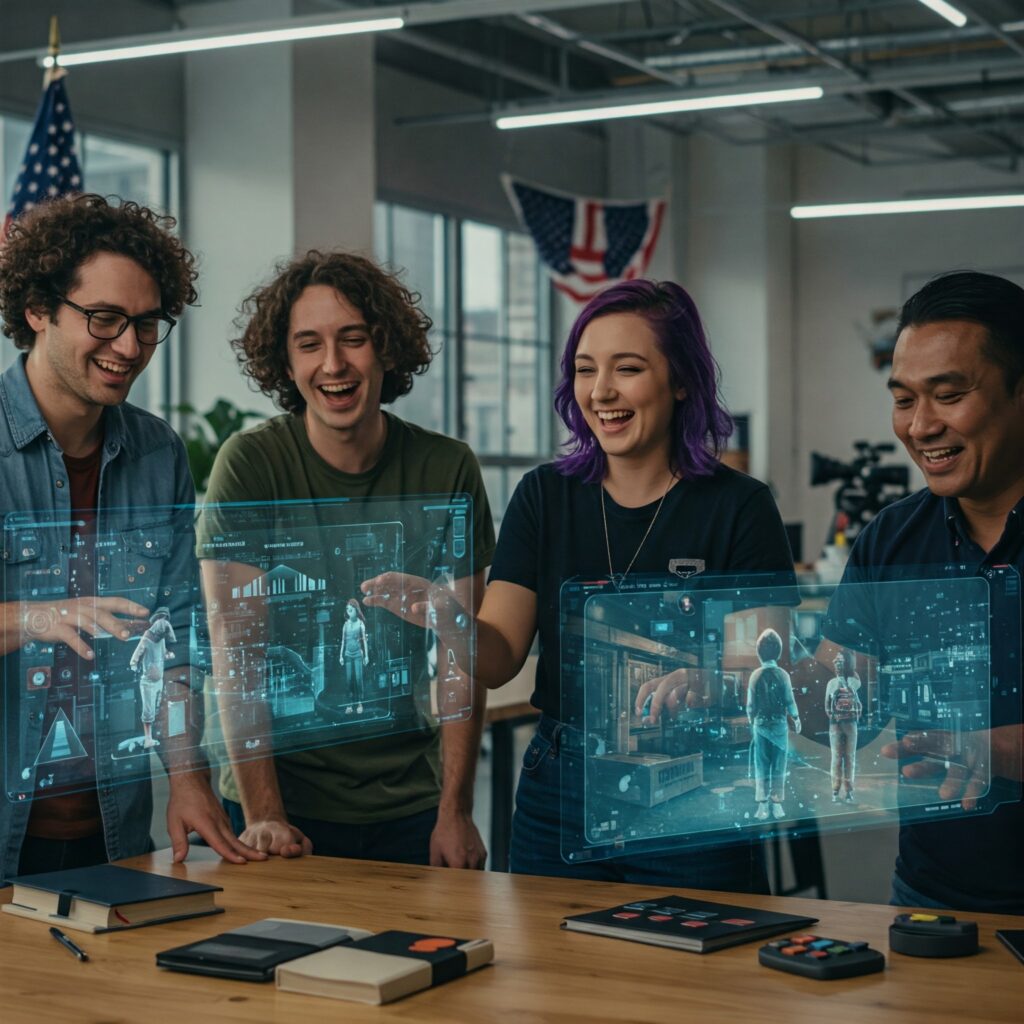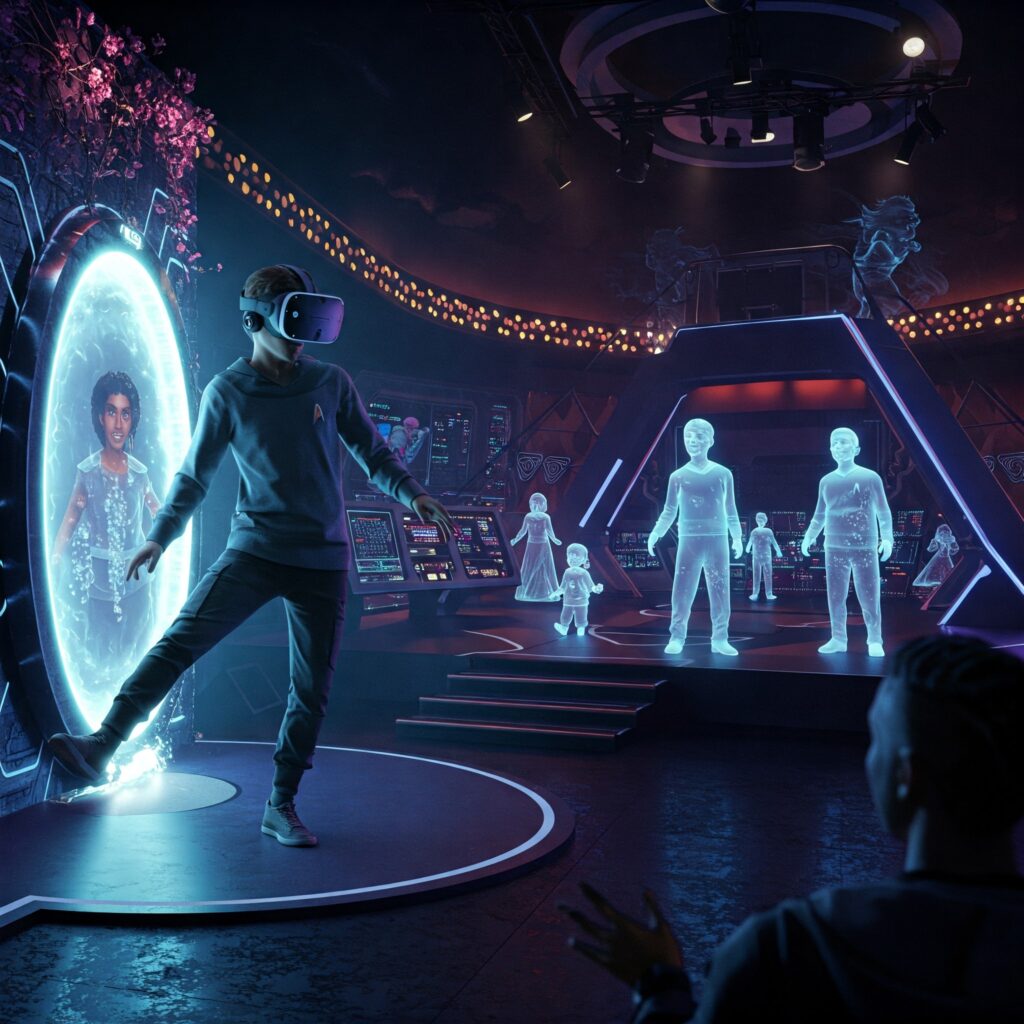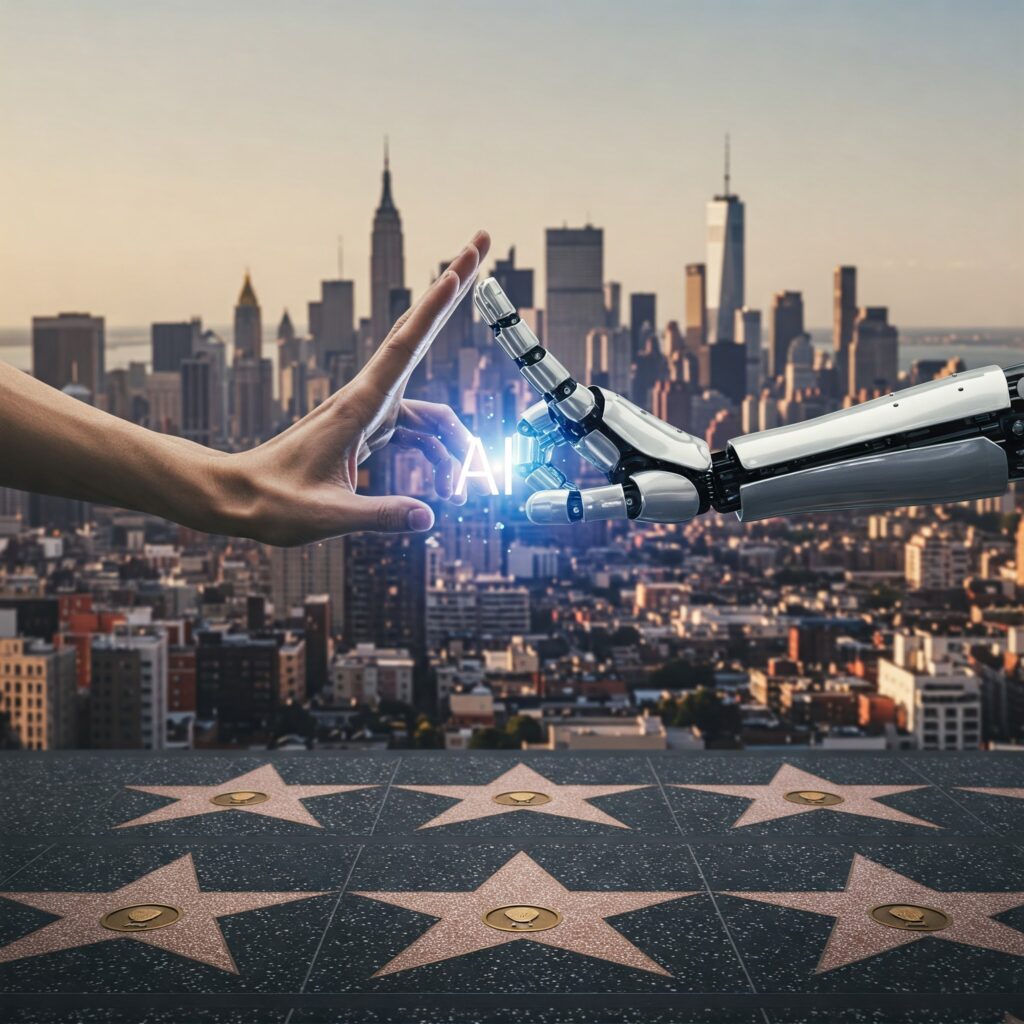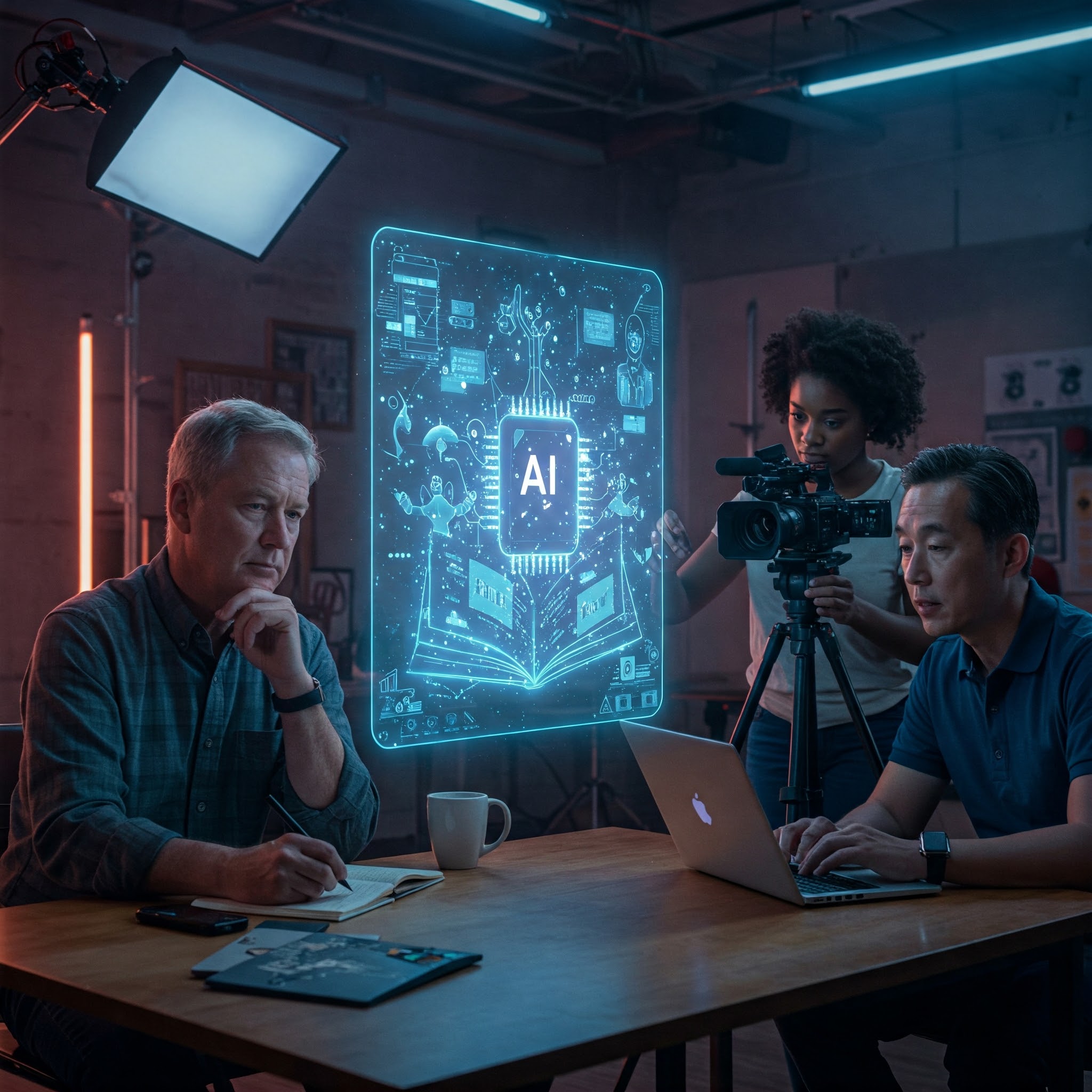Introduction: The New Chapter of Storytelling

Imagine a Hollywood screenwriter collaborating with AI to brainstorm plot twists that leave audiences gasping. Or a self-published author in Texas using AI to turn a rough draft into a bestseller. In 2025, AI-driven storytelling isn’t just a trend—it’s reshaping how stories are told in the U.S., with 86% of senior entertainment execs banking on AI to boost content speed and innovation. This guide dives into how AI is transforming narratives, the tools powering this revolution, and what it means for creators and audiences alike.
What is AI-Driven Storytelling? Think of It as Your Creative Sidekick

AI-driven storytelling leverages machine learning and natural language processing to assist or automate tasks like generating plots, characters, and interactive narratives. In the U.S., writers and filmmakers use tools like GPT-5 and StoryGenius to break creative blocks and scale production. Think of AI as a brainstorming partner that never sleeps—suggesting quirky character traits or adapting stories in real-time based on audience choices.
How AI is Rewriting the Rules

In 2025, AI-driven storytelling is revolutionizing the creative process across multiple dimensions in the U.S., transforming how ideas come to life and stories unfold. One key application is idea generation, where AI analyzes cultural trends and audience data to suggest concepts with viral potential—take Sunset Connection, for example, which used AI to test five distinct endings, ensuring the most captivating one made the cut. Then there’s character development, where tools like StoryGenius craft multidimensional backstories with ease; imagine a gritty detective whose secret passion for baking sourdough adds unexpected depth, all dreamed up by AI. For interactive narratives, AI takes personalization to new heights by adapting stories to user choices in real-time—Netflix’s City of Mirrors exemplifies this, letting viewers steer the plot down different paths for a bespoke experience. Finally, visual storyboarding empowers creators by instantly converting text into vivid images; indie filmmakers across the U.S. rely on VisualStory to whip up pitch decks that dazzle producers without the wait. Together, these advancements showcase how AI-driven storytelling is rewriting the rules, blending innovation with practicality for American creators.
Top AI Tools for U.S. Creators in 2025
| Tool | Key Features | Best For | USP for the U.S. Market |
|---|---|---|---|
| GPT-5 | Advanced scripts, dialogue, SEO content | Screenwriters, novelists | 40% faster drafting for tight deadlines |
| StoryGenius | Predictive plot arcs, emotional analysis | Game designers, fiction writers | Used by 70% of top U.S. indie game studios |
| EmotionAI | Ensures tone matches audience sentiment | Marketers, PR teams | Boosts engagement by 53% |
| Jasper | Hyper-personalized ad campaigns | Enterprise marketers | Generated 20x ROI for brands like Ulta Beauty |
Why U.S. Creators Are Embracing AI
- Efficiency: AI cuts writing time by 30%, letting creators focus on high-value tasks like editing and brand voice refinement.
- Personalization: 40% of U.S. audiences have tried interactive AI-driven content (e.g., Netflix’s choose-your-own-adventure shows).
- Democratization: Free tools empower hobbyists—like a Texas teen whose AI graphic novel landed a publishing deal.
- Innovation: AI-generated short films like Synthetic Dreams won awards at Sundance 2024.

Challenges & Ethical Considerations
| Challenge | Risk | Industry Response |
|---|---|---|
| Transparency | Audiences distrust AI-generated content | 63% of consumers demand clear AI labeling |
| Plagiarism | AI mimics existing works | Studios use copyright bots to audit AI drafts |
| Bias in Algorithms | Reinforces stereotypes | Ethicists audit datasets (e.g., Pfizer’s AI oversight) |
| Loss of Human Touch | Content feels generic | Human-AI hybrids dominate Oscar-nominated scripts |
Future Trends: What’s Next for AI-Driven Storytelling in the U.S.?

1. AI + VR Storyliving: Imagine stepping into a Star Trek-style holodeck where narratives adapt to your choices (projected $92B AR/VR market by 2027).
2. Real-Time Adaptation: Live theater scripts that shift based on audience reactions (testing in Broadway 2026).
3. Hyper-Personalized Ads: Jasper’s AI-driven campaigns achieved 11x more clicks than traditional emails.
4. Ethical AI Governance: 93% of execs prioritize Responsible AI to build trust.
Case Study: How Jasper’s AI Tool Scaled U.S. Marketing
In 2024, Jasper’s AI tool proved its mettle in the U.S. marketing landscape, showcasing how AI-driven storytelling can scale personalized experiences beyond human capacity. Tasked with elevating Ulta Beauty’s outreach, the tool powered the creation of 2,000 hyper-personalized email campaigns, each tailored to individual preferences with precision no human team could match in such volume. The results were staggering: a 20x return on investment that underscored AI’s financial impact, alongside engagement metrics that blew traditional efforts out of the water—2.9 times more opens and an impressive 11 times more clicks compared to standard campaigns.
The key takeaway? AI-driven storytelling doesn’t just automate—it crafts bespoke narratives at scale, delivering results that redefine what’s possible in U.S. marketing.
Source: Jasper’s 2024 campaign for Ulta Beauty
Conclusion: The Winning Formula for U.S. Creators
The future of storytelling isn’t a battle between AI and humans—it’s a powerful collaboration. As Gary Vaynerchuk puts it, “Brands mastering storyliving will lead the pack.” To succeed with AI-driven storytelling in 2025:
- Harness AI to streamline workflows and personalize content.
- Preserve human creativity to ensure genuine emotion and authenticity.
- Take fearless risks, like the New York Times’ bold 2011 paywall move.
Eager to get started? Check out these top AI tools transforming U.S. storytelling:
Jasper: Drive high-ROI ad campaigns with precision.
GPT-5: Craft scripts and SEO-optimized blogs with ease.
VisualStory: Generate instant storyboards for filmmakers.

FAQ: AI-Driven Storytelling in 2025
- Can AI Make a Difference in Storytelling? Yes—AI-driven storytelling is transforming the craft. In 2024, AI models evolved into co-authors, creating stunning narratives. By 2025, 86% of U.S. entertainment execs rely on AI to speed up content and spark innovation, proving its game-changing role.
- What is the Future of AI Storytelling? The future of AI-driven storytelling is limitless. Expect immersive VR “storyliving” experiences (a $92B market by 2027) and live theater scripts adapting to audience reactions by 2026. From custom kids’ books to interactive films, AI will personalize storytelling like never before.
- How is AI Reshaping Storytelling? AI-driven storytelling redefines narratives in books, games, and movies. It generates viral ideas, crafts rich characters, and adapts plots to viewer choices—like Netflix’s City of Mirrors. U.S. creators use it to boost production and creativity, making stories more dynamic.
- What Can AI Do for Storytelling? AI-driven storytelling empowers creators with:
- Scriptwriting: GPT-5 cuts drafting time by 40%.
- Character Development: StoryGenius builds unique backstories (e.g., a baking detective).
- Plot Generation: EmotionAI matches tones to audience feelings.
- Personalization: Jasper delivers 20x ROI for tailored campaigns. It’s paving the way for deeper, customized experiences.
- Is AI Storytelling Ethical? AI-driven storytelling offers huge potential but poses challenges. Biased algorithms might reinforce stereotypes, and over-reliance could dilute the human touch. Ethical oversight—like auditing datasets and labeling AI content (demanded by 63% of consumers)—is key to keeping it responsible.
- How is AI Shaping the Content of a Story? AI-driven storytelling shapes content by analyzing trends for fresh ideas, generating detailed characters, and adapting narratives in real-time. Tools like StoryGenius predict emotional arcs, while Jasper personalizes ad stories, ensuring content resonates with U.S. audiences.
Connect With Us
Love storytelling and tech? Stay ahead with Next Entertainment Wave! Join our community for the latest on AI-driven storytelling in 2025, groundbreaking tools, and U.S. entertainment trends delivered right to your inbox. Here’s how:
- Subscribe: Sign up for our newsletter for exclusive AI storytelling insights and updates.
- Follow Us: Catch us on
- Share Your Thoughts: Drop a comment below—tell us your favorite cloud gaming platform or what you’re excited for in 2025! Let’s game on together—connect today!
- Get in Touch: Have questions or ideas? Email us at info@nextentertainmentwave.com—we’d love to hear from you!


[…] Jasper, another AI tool making waves. US retailer Ulta Beauty used it to craft a 2023 campaign, generating […]
[…] trend is part of a larger wave of AI action figure innovation, where artificial intelligence empowers anyone to become a toy designer. No art skills? No 3D modeling experience? No worries. With ChatGPT action […]